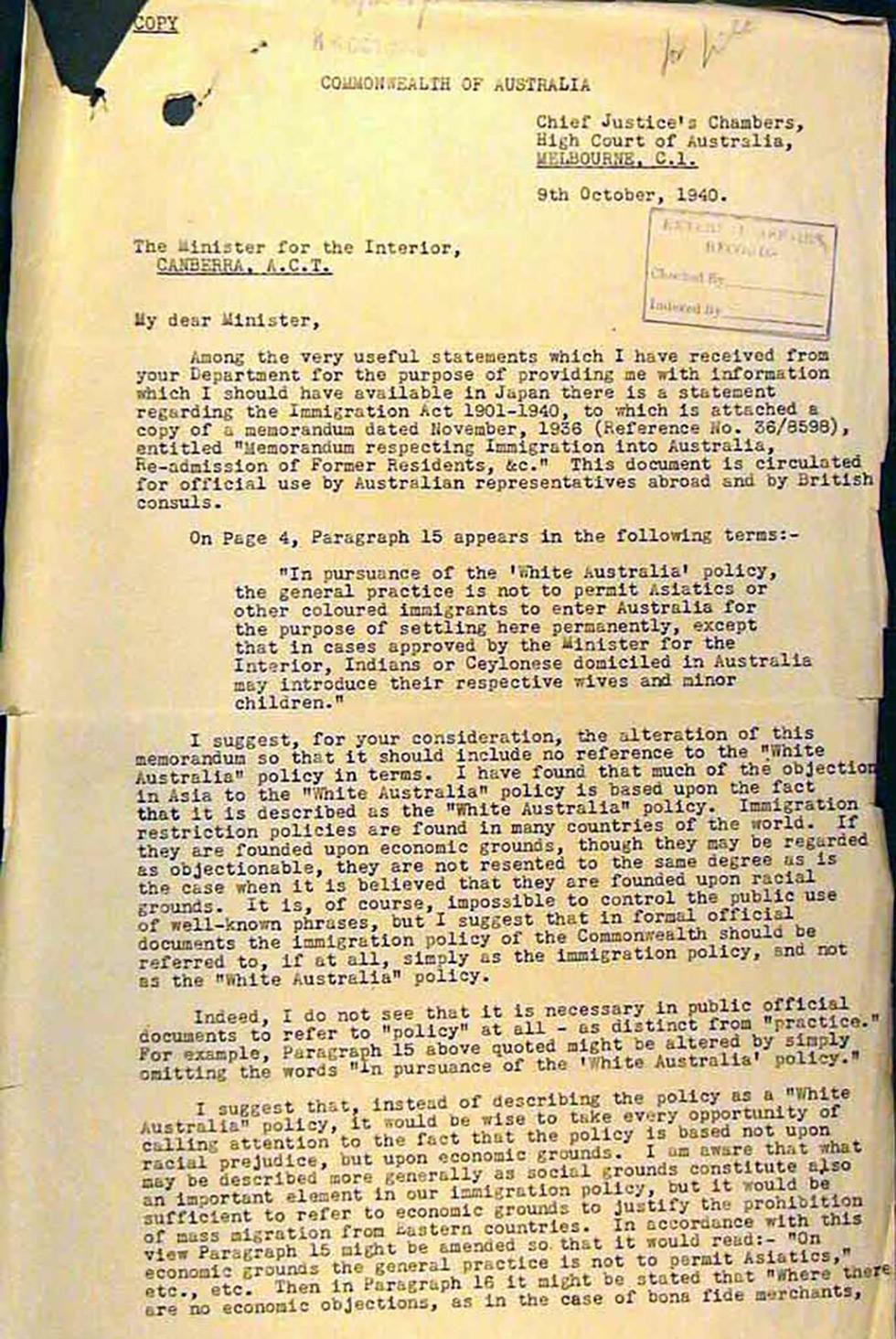
Copy of a letter to the Minister for the Interior to consider altering the White Australia policy.
Aboriginal and Torres Strait Islander people should be aware that the National Archives' website and collection contain the names, images and voices of people who have died.
Some records include terms and views that are not appropriate today. They reflect the period in which they were created and are not the views of the National Archives.


Copy of a letter to the Minister for the Interior to consider altering the White Australia policy.
COPY [underlined]
COMMONWEALTH OF AUSTRALIA
Chief Justice's Chambers,
High Court of Australia,
Melbourne, C.1.
[Stamp in blue ink reads 'EXTERNAL AFFAIRS RECORDS', 'Checked by [blank space]', 'Indexed by [blank space]'.]
9th of October, 1940
The Minister for the Interior,
>CANBERRA, A.C.T. [underlined]
My dear Minister,
Among the very useful statements which I have received from your Department for the purpose of providing me with information which I should have available in Japan there is a statement regarding the Immigration Act 1901-1940, to which is attached a copy of a memorandum dated November, 1936 (Reference No. 36/8598), entitled "Memorandum respecting Immigration into Australia, Re-admission of Former Residents, &c." This document is circulated for official use by Australian representatives abroad and by British consuls.
On Page 4, Paragraph 15 appears in the following terms: -
"In pursuance of the 'White Australia' policy, the general practice is not to permit Asiatics or other coloured immigrants to enter Australia for the purpose of settling here permanently, except that in cases approved by the Minister for the Interior, Indians or Ceylonese domiciled in Australia may introduce their respective wives and minor children."
I suggest, for your consideration, the alteration of this memorandum so that it should include no reference to the "White Australia" policy in terms. I have found that much of the objection in Asia to the "White Australia" policy is based upon the fact that it is described as the "White Australia" policy. Immigration restriction policies are found in many countries of the world. If they are founded upon economic grounds, though they may be regarded as objectionable, they are not resented to the same degree as is the case when it is believed that they are founded upon racial grounds. It is, of course, impossible to control the public use of well-known phrases, but I suggest that in formal official documents the immigration policy of the Commonwealth should be referred to, if at all, simply as the immigration policy, and not as the "White Australia" policy.
Indeed, I do not see that it is necessary in public official documents to refer to "policy" at all - as distinct from "practice." For example, Paragraph 15 above might be altered by simply omitting the words "In pursuance of the 'White Australia' policy."
I suggest that, instead of describing the policy as a "White Australia" policy, it would be wise to take every opportunity of calling attention to the fact that the policy is based not upon racial prejudice, but upon economic grounds. I am aware that what may be described more generally as social grounds constitute also an important element in our immigration policy, but it would be sufficient to refer to economic grounds to justify the prohibition of mass migration from Eastern countries. In accordance with this view Paragraph 15 might be amended so that it would read: - "On economic grounds the general practice is not to permit Asiatics," etc., etc. Then in Paragraph 16 it might be stated that "Where there are no economic objections, as in the case of bona fide merchants,
[END OF RECORD EXCERPT.]
Learn how to interpret primary sources, use our collection and more.
